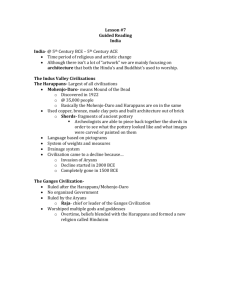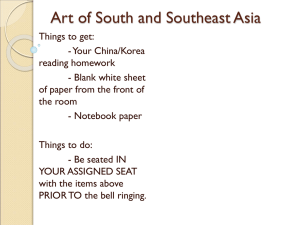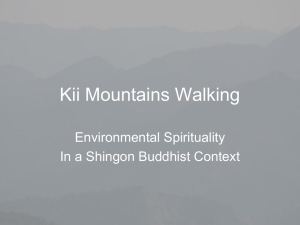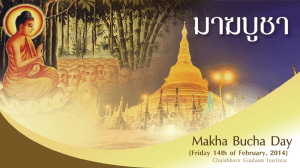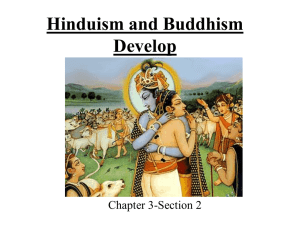Sculpture
advertisement
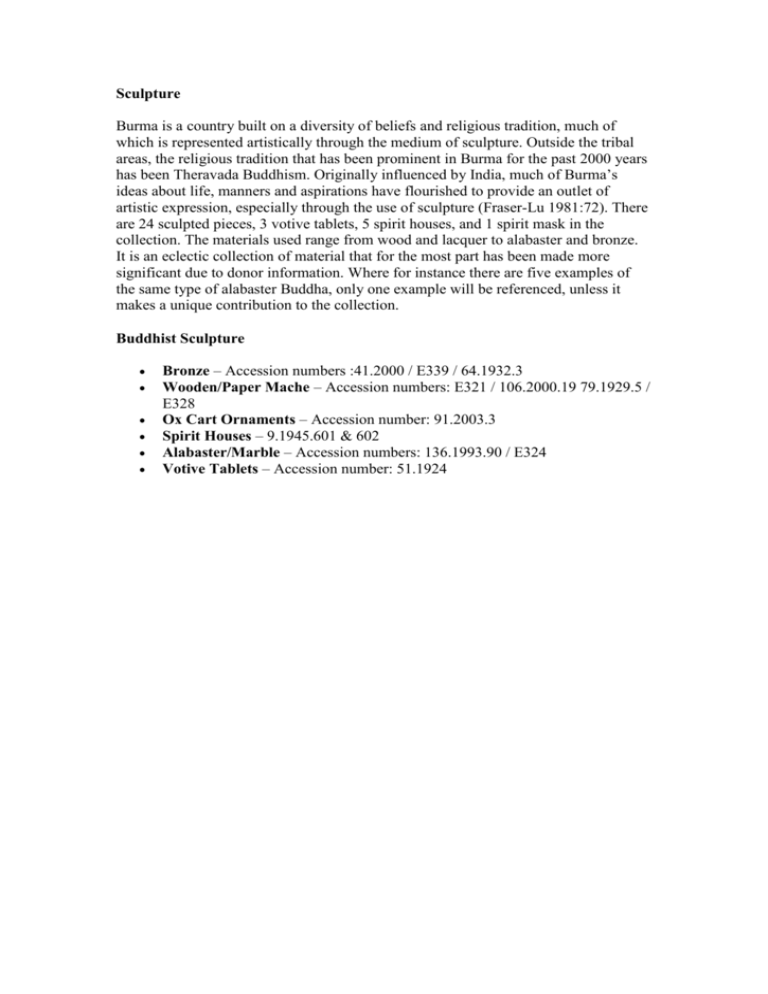
Sculpture Burma is a country built on a diversity of beliefs and religious tradition, much of which is represented artistically through the medium of sculpture. Outside the tribal areas, the religious tradition that has been prominent in Burma for the past 2000 years has been Theravada Buddhism. Originally influenced by India, much of Burma’s ideas about life, manners and aspirations have flourished to provide an outlet of artistic expression, especially through the use of sculpture (Fraser-Lu 1981:72). There are 24 sculpted pieces, 3 votive tablets, 5 spirit houses, and 1 spirit mask in the collection. The materials used range from wood and lacquer to alabaster and bronze. It is an eclectic collection of material that for the most part has been made more significant due to donor information. Where for instance there are five examples of the same type of alabaster Buddha, only one example will be referenced, unless it makes a unique contribution to the collection. Buddhist Sculpture Bronze – Accession numbers :41.2000 / E339 / 64.1932.3 Wooden/Paper Mache – Accession numbers: E321 / 106.2000.19 79.1929.5 / E328 Ox Cart Ornaments – Accession number: 91.2003.3 Spirit Houses – 9.1945.601 & 602 Alabaster/Marble – Accession numbers: 136.1993.90 / E324 Votive Tablets – Accession number: 51.1924 Bronze 41/2000 – Seated Buddha This bronze Buddha is seated in Vajrasana (lotus), the left hand is in dhyanamudra (meditation), and the right hand in bhumisparsamudra (touching the earth). Bhumisparsamudra is associated with the enlightenment of the Buddha at Bodhgaya. The shoulder robe is squared-off, which is a later stylistic development. The Buddha is sat on a high pedestal. Although the donor is unknown, the image was viewed by John Guy of the V & A who dated the piece to the late 18th Century. Stylistically, the piece shows many Shan state Buddhist sculptural characteristics such as the oval face with the wide nostrils, the small mouth upturned in half smile, the large ears swinging out to touch the shoulders, and the three characteristic creases visible on the neck (Fraser-Lu 1981:67). A very similar example of this sculpture has been documented in ‘Arts of Asia’, Vol. 11, No. (Fraser-Lu 1981 : 69). Further examples of Shan influenced Buddhist Sculpture can be seen in Burmese Buddhist Sculpture (The John MÅ‘gar Collection) (Karow 1991:80-84). E339 – Seated Buddha This bronze Buddha is seated in Vajrasana (lotus). The left hand is in dhyanamudra (meditation), and the right hand in bhumisparsamudra (touching the earth). Bhumisparsamudra is associated with the enlightenment of the Buddha at Bodhgaya. The figure has broad shoulders and a slim waist. There are some signs of gilding, which has eroded. The donor of this object was a Mrs Stone of 36 High Street, Exeter, and the piece was acquired by the museum in 1876. Unfortunately, the provenance is unknown. An image of the figure was assessed by John Guy of the V & A, who suggested that ‘it followed the Classical Pagan Model, with the squared-off shoulder tending to be a later feature….and that the sculpture may have previously had a base as in 41.2000, but it appeared to have broken off’ (Pers. Comm. 2005). 64.1932.3 – Reclining Buddha This bronze reclining Buddha image is of the Mandalay style. The lying down posture of the image represents the Buddha’s death Parinirvana (the dying or passing into Nirvana, the ultimate goal of devout Buddhists). He is shown lying on his right side with his cheek resting on his right hand propped up by his elbow. The ears and usnisha are stylistically of the Mandalay style period, which has developed since the end of the 18th century. A similar example has been documented in ‘Arts of Asia’ (Vol.11, No.2 March-April) (Fraser-Lu 1981: 71). Wooden/Paper Mache Sculpture E321 – Seated Buddha This seated Buddha, which is of good condition is made of wood, preserved in lacquer and decorated with gold leaf. He sits with the soles of his feet in his lap, with his left hand in dhyanamudra (meditation), and the right hand in bhumisparsamudra (touching the earth). The fingers are exaggeratedly long. The robe on the chest is plain, but over the legs forms rippling drapery. The face is rectangular and indicates influence from the medieval style developed at Pagan. The eyebrows are stylized and almost form an ‘L’-shaped outline. An inscription around the base reads in English ‘Sitting Budh or Buddha. A Burmese Idol’. It has been suggested that this was inscribed after the sculpture reached Exeter (Isaacs 2000:130). The donor of the piece was Captain Truscott, a member of the East India Company Army. Although a date of late 18th/early 19th century has been suggested, an exact provenance is unknown (Isaacs 2000:130). The piece is significant to the collection and has been documented in ‘Vision from the Golden Land, Burma and the Art of Lacquer’ (Isaacs 2000:130). There is almost an exact copy currently in the British Museum. 106.2000.19 –Seated Buddha This seated Buddha is made of wood, and decorated with a gold pigment. The base is painted red. The Buddha is seated in Vajrasana (lotus), the left hand is in dhyanamudra (meditation), and the right hand is in bhumisparsamudra (touching the earth). Beneath him are two accompanying seated Buddhas. The donor is unknown, however the exact provenance and date of Accession in Burma is known. On the back of the Buddha is an original label stating the following: 24 ‘Burmese god taken from hpoongie (priest) house in one of the Kubbo Valley Villages by a sepoy of the 42nd Gurkha I.I’s in the Kubbo Valley. Field Force, Burmah, 1886-87’ An image of this object was viewed by John Guy of the V & A, who highlighted the fact that although the piece itself is not that significant compared to other sculptural pieces, it is significant of its time, because the original date and provenance can be located (Pers. Comm. 2005). 79.1929.5 – Seated Buddha This seated Buddha is made of wood and decorated with gold pigment. The Buddha is seated in Vajrasana (meditation) with the right hand in Bhumisparsamudra (touching the earth). It is suggested that thayo has been used to create the stucco effect indicating the falling of the robe over the left shoulder. On the back of the sculpture there is a hollowed compartment, which is either for attachment or there for the use of inserting an offering or amulet. An image of this Buddha was assessed by John Guy who indicated that it was really a generic model. The reason it has been included it in the report is because of the use of the thayo technique, and also because of the compartment. Although no provenance is known, the object was accessioned to the museum in 1929 by Miss G. Jackson of Dawlish. Therefore, the sculpture must pre-date the 1920’s. E328 – Seated Buddha This ornately decorated seated Buddha is made of paper-mache. It has then been lacquered and either painted or gilded and inlayed with colour glass. Lacquer mixed with bone ash can provide moulded decoration for hair, jewellery, and borders on clothing. The lacquer also provides a base for the inlay of coloured glass and mirror, which was popular in later images. The Buddha is seated in Vajrasana (lotus), with the left hand in dhyanamudra (meditation), and the right hand in Bhumisparsamudra (touching the earth). The red painted base on which the Buddha is sitting has an inscription ‘The Sitting Budh’, which may have been added when the object was accessioned. The Buddha is ornately decorated with turquoise, green and purple glass. The ears have holes in the lobes. Further information regarding Buddhist images made from wood and lacquer can be obtained from ‘Arts of Asia’ (Vol. 11, No.3, May-June) edited by Sylvia Fraser-Lu. Although the provenance is unknown, the donor is the wife of the late Mr F.W. Locke Ross, who died in 1860, and therefore the object must pre-date the 1860’s. An image of the object was assessed by John Guy of the V & A who suggested that the piece was of Mandalay Court Style (which developed end of 18th/early 19th century), and was probably new when Locke bought it (Pers.Comm 2005). Spirit Houses – 9.1945.601 & 602 There are five spirit houses in the collection at the RAMM. These forms of sculpture are also known as Natsin. These two pieces were donated by Waterfield in 1945, but exact provenance is unknown. The objects are heavily corroded but relate to the Nats, which are the Burmese spirits of nature or deceased ancestors. There are 37 main Nats, which relate to Burmese life. The appeasement and worship of Nats is conducted alongside the practice of Buddhism, and as seen in the image on the right there is a Buddhist sculpture incorporated into the spirit house. Although there are better examples of spirit houses in other collections, these pieces are significant to the collection because they provide an insight into how malleable the medium of sculpture can be in accommodating various belief systems. Marble/Alabaster 136/1993/90 This seated Buddha has been carved out of marble. There are traces of gold and red pigment on the body of the sculpture. The Buddha is seated in Vajrasana (lotus), the left hand is in dhyanamudra (meditation), and the right hand is in Bhumisparsamudra (touching the earth). The oval face is separated from the hair line by a fillet band. The head is marked by rows of small, slightly raised curls. A thick round usnisha sits at the crown of the head. The arch of the eyebrows is very natural, but the nose is prominent. Viewed straight on, the ears curve outwards and touch the shoulders. Provenance and original owner is unknown however the object was accessioned to the RAMM from Woodspring Museum in Weston-Super-Mare. An image of the object was viewed by John Guy of the V & A, who suggested that the sculpture was of Mandalay Style and a date of 19th century was given. Similar Mandalay image sculpture has been documented by Sylvia Fraser-Lu in ‘Arts of Asia’ (1981, Vol.11, No.1, Jan-Feb, p.72-82) E324 – Alabaster Seated Buddha This seated Buddha is sculpted out of alabaster and there are traces of gold and red pigment. The Buddha is seated in Vajrasana (lotus), the left hand is in dhyanamudra (meditation), and the right hand is in Bhumisparsamudra (touching the earth). Although provenance is unknown, the object was donated to the museum in the late 1800’s by Mr Ross of Topsham, wife of Mr Locke Ross. Therefore, the piece can be dated to pre-late 1800’s. There are two other pieces in the collection: 66/2003, and 79/1929/3 that share similar characteristics to E324. The Buddha has all the stylistic characteristics of the Mandalay Workshop. An image of the object was viewed by John Guy of the V & A, who suggested that the sculpture was of Mandalay Style and that those images sculpted out of poorer material were literally churned out in the Mandalay workshops to enable the devotees that bought them to gain merit. The reason the Mandalay Workshop Buddha’s are included in the report is because they represent a fundamental element of Buddhist day-to-day life in Burma: the endless pursuit of gaining merit. Votive Tablets – 51.1924 There are three votive tablets in the collection at the RAMM. They can all be dated to the Late Pagan Period (13th Century A.D.) The quality of the tablets is similar and therefore in this report tablet 51.1924, which was donated by Mr E.H. Willcock of Exeter, is being described. The clay votive tablet is of a deep reddish colour, which suggests that the tablet was fired. The sculpture depicts the Buddha seated beneath the tower of Mahabodhi temple at Bodhgaya in Eastern India. The temple marks the most holy of Buddhist pilgrimage sites, the site being where the meditating Buddha resisted the temptations sent by Mara (the embodiment of evil) prior to his enlightenment. The Buddha is flanked by two attending Buddhas. It is possible that there is a horizontal inscription located beneath the seated Buddha, though if so it is heavily corroded. The majority of tablets from the Pagan period carry at least one line of Buddhist scriptures, which is predominantly, the ‘ye dharma’ verse: ‘he who sees the dharma sees me; he who sees me sees the dharma’. Votive tablets were made by faithful Buddhists in the shape of circles, bodhi leaves and windows. They were made in abundance as offerings and were enshrined in pagodas all over Burma as an act of merit and as a means of propagating the faith. Votive tablets are notoriously difficult to place because of the mobility of the tablets and the mobility of the moulds. An almost identical tablet is currently on display in the V & A Museum.


